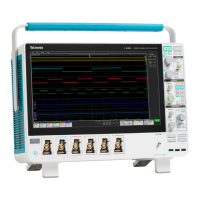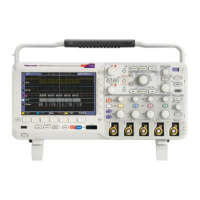Trigger Setup
USB Bus Trigger
You can trigger on Sync, Reset, Suspend, Resum e, End of Packet, Token (Address) Packet, Data Packet, Handshake
Packet, Special Packet,orError.
Ethernet Bus Trigger
You can trigg
er on Start Frame Delimiter, MAC Addresses, MAC Length/Type, TCP/IPv4 C lient Data, End of Packet,
Idle,oranFCS (CRC) Error.IfyouturnonQ-(VLAN) Tagging, you can also trigger on MAC Q-Tag Control Information.
MIL-STD-1553 Bus Trigger
You can trigger on Sync, Command, Status, Data, Time (RT/IMG),orError.
If you are setting up a MIL-STD-1553 trigger and have made a Trigger On selection of Command, push RT Address on the
lower m enu to enter specific values of RT Address to trigger on. Push Command Word Details on the lower menu to enter
the T/R bit value, Subaddress/Mode value, Word Co unt/Mode C ode value, and Parity value.
If you are setting up a M IL-STD-1553 trigger and have m ade a Trigger On selection of Status, push l RT-Address on the
lower m enu to enter specific values of RT Address to trigger on. Push Status Word Bits on the lower menu to enter values
for Message Error (bit 9), Instr. (bit 10), Service Req. (bit 11), BCR (bit 15), Busy (bit 16), Subsystem Flag (bit
17), DBCA (bit 18), Terminal Flag (bit 19) and Parity.
If you are setting up a MIL-STD-1553 trigger and have made a Trigger On selection of Data, push Data on the lower
menu to enter specific Data values, and the Parity value.
If you are setting up a MIL-STD-1553 trigger and have made a Trigger On selection of Time (RT/IMG), push Trigger When
on the lower menu to set the trigger condition. Push Times on the lower menu to set the Maximum and Minimum times.
If you are setting up a MIL-STD-1553 trigger and have made a Trigger On selection of Error
, push Error Type on the lower
menu to select the type of error to trigger on.
I
2
C, SPI, USB, Ethernet, CAN, LIN, and FlexRay Bus Trigger Data Matching
Rolling window byte matching for I
2
C, SPI, USB, and FlexRay. To use a rolling w indow to trigger on data, you
define the number of bytes to match. Then the oscilloscope uses a rolling window to find any match within a packet,
with
the window rolling one byte at a time.
For e
xample, if the number of bytes is one, the osc ill oscope will attempt to m atch the first byte, second byte, third, and so
on within the packet.
If the number of bytes is two, the oscilloscope will try to m atch any two consecutive bytes, such as one and two, two and
three, three and four, and so on. If the oscilloscope fi nds a match, it will trigger.
With FlexRay, USB , or Ethernet, obtain a rolling window match by setting the Byte Offset in the Data menu to Don't care.
MSO4000B and DP O4000B Series Oscilloscopes User Manual 85
